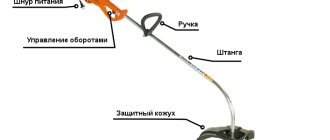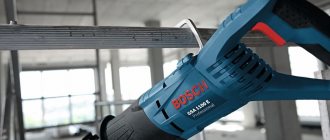Purpose and advantages of the cultivator
The cultivator is one of the most popular agricultural machines. Due to the simplicity of design and control, cultivators are widely used in professional farms and private farms.
The device can simultaneously perform several types of soil treatment:
- Soil loosening is the process of mechanically digging up the top layer of soil, as well as breaking down large lumps of earth into smaller ones. Thanks to loosening, moisture is better absorbed into the ground, and the soil itself is able to pass oxygen to plant roots in greater quantities.
- Hilling, by which moist soil, containing small clumps or having the consistency of sand, is delivered directly to the roots of the plant. Thanks to this technique, seeds begin to germinate faster, and the finished seedlings receive more moisture and dry less in the air.
- Weed control, which occurs through hilling, as well as mechanical cutting of the roots and green part of the weed plant. In essence, a cultivator is an alternative to the massive use of herbicides (substances that inhibit the growth of weeds and at the same time clog the soil).
Thus, this device has many advantages:
- cultivators are popular and one of the most reliable agricultural machines: thanks to the simply designed unit, it is easy to care for, and the durability of the mechanism allows it to be used for several seasons in a row;
- thanks to this device, the farmer significantly saves his time and effort; even the simplest machines combine several of the functions listed above.
- there is a huge selection of cultivators on the market today, so it is quite possible to choose a machine specifically for your needs and for almost any budget (prices usually start from 7-8 thousand rubles);
- finally, if you have available tools, mechanisms and certain skills, you can assemble the cultivator yourself - detailed instructions and video material can be seen in the corresponding section.
Cultivator device
The modern agricultural machinery market offers a huge selection of cultivators - from the simplest models to the most reliable and popular. Their design can vary quite a lot depending on the work performed, as well as on the specific model. However, the fundamental structure of different types of cultivators is the same:
- Metal frame (body-base) with wheels and handles.
- A gasoline or electric engine is the source of energy for the operation of the mechanism.
- The engine energy in the form of torque is supplied to a special gearbox connected by a belt.
- The gearbox, in turn, transmits energy to the shaft. The shaft is the working part of the cultivator. Various cutting devices are installed on it:
- universal paws;
- longitudinal;
- lancet;
- loosening;
- dump paw;
- Okunchaki;
- feeding knife;
- needle-shaped disks, consisting of several identical sections.
All these working bodies perform different functions - their purpose is described in more detail in the table.
| razors (flat-cutting blades that are located on 1 side) | trim the roots and green part of the weeds |
| pointed paws flat-cutting | they also trim the weeds, but also loosen the top part of the soil to 5-6 cm in depth |
| universal pointed feet | provide great functionality: tillage between rows and in continuous form (depth up to 13-15 cm); crushing clods, loosening and trimming weeds |
| chisel-shaped paws (chisel-shaped) | loosening the soil (depth up to 16 cm), simultaneously grasping up to 2 cm of soil in length |
| Feeding knives | applying mineral and organic fertilizers to the soil up to 15 cm deep, loosening the upper part of the soil and sealing reliefs and furrows after plowing |
| hillers | cutting weeds, creating ridges on the field surface, loosening the soil up to 15 cm |
| arychnik | Along with the functions of hillers, they are used to apply fertilizing to the ground |
| needle discs | primary tillage at the beginning of the season or after a long drought - removing the top dried layer |
| harrows | loosening the soil completely and between rows |
The components of some working bodies are presented in the diagram.
The very device of the hand cultivator in a generalized form is also presented in the figure.
The purpose of some parts is presented in the table.
| air damper | fixed in different positions to turn on the engine “cold” |
| starter handle | use it to turn on the engine |
| lever for controlling cutters | with its help, the movement of the working mechanism is carried out - the cutters engage each other and begin to work |
| deepener | key setting element: with its help you can select the desired speed of movement, as well as the depth of loosening the earth |
| throttle valve | Using the damper regulator, you select the desired engine speed |
If we consider the cultivator as a unit, we can say that it consists of 4 main parts:
- Engine (electric, diesel or petrol).
- Transmission.
- Axle with wheels.
- Machine control system during operation.
Model range "Neva"
Summer residents and farmers today have the opportunity to purchase Russian motor cultivators “Neva”:
- MK-200. This is the most powerful model produced. It is intended for processing large areas. The power of the Neva MK-200 engine is 4 liters. With. A distinctive feature of this model, in comparison with most other modern cultivators, is the presence of two forward gears at once. Moreover, the MK 200 also has reverse speed.
- MK-80. The engine power of this model is 2.6 liters. With. If desired, up to 6 cutters can be installed on the MK-80. The working width of this model is 90 cm, and it plows the soil to a depth of 16 cm. It is believed that the MK-80 cultivator is well suited for a plot of 10-12 acres.
- MK-75. This Russian motor-cultivator is functionally and structurally similar to the MK-80. The only thing is that it has a smaller swath width (54 cm). It is allowed to install 4 cutters on this model. The manufacturer recommends it for plots of 5-10 acres.
- MK-45. This model is equipped with a 1.2 liter engine. With. It is recommended to use it mainly for loosening beds in greenhouses and open ground. The working width of this cultivator is 20 cm, and the plowing depth is 14 cm.
It also supplies the market with a line of MK-100 cultivators. Models in this series are quite heavy and equipped with powerful engines. Some of them, among other things, are equipped with protective discs that prevent crop plants from being drawn into the working body during weeding.
Cultivator and walk-behind tractor: what is the difference
The cultivator can be considered as a device that is on a par with other means of mechanization of modern agriculture:
- electric hoe;
- walk-behind tractor;
- motor cultivator.
Cultivators and walk-behind tractors are often confused . Although these are similar devices, there are differences between them. The main ones are presented in the table.
| comparison sign | cultivator | walk-behind tractor |
| appointment | soil treatment only | soil treatment, as well as other work: a pump, trolley, lights, knives for digging trenches, etc. can be mounted to the device. |
| weight | much less | a lot more |
| power |
Thus, if a farmer needs a tool only for cultivating the land, he should only choose between cultivators
. In addition, you can purchase an electric hoe - thanks to its small size, weight and mobility, it can be used to get into hard-to-reach places, and can also be used for periodic processing of a small garden (while the cultivator is working on a large field).
Most popular models
The most frequently purchased cultivator of this brand is the “Mole” MK9-01. This model has a 5.5 liter engine. With. Its maximum working width for arable land is 60 cm. At the same time, this cultivator can cultivate the soil to a depth of up to 25 cm.
If desired, summer residents can purchase less expensive and powerful units of this brand. For example, the Russian-made Krot motor cultivators MK5-01 and MK7-A-02 have earned quite good reviews from consumers. Their working width and plowing depth are the same - 60 and 25 cm, respectively. But the MK7-A-02 model has a more powerful engine - 4 liters. s (on MK5-01 - 3.5 hp).
Technical characteristics and rules for choosing a cultivator
Among the key technical characteristics on the basis of which you can evaluate the model and understand how well it suits your particular site include the following:
- The working width and the size of the cutters (cm) - these are the parameters that affect productivity and directly determine how many rows and how long it will take to complete when working with the device.
- Plowing depth (cm) is an equally important indicator that should always be taken into account based on the nature of the soil, as well as the types of crops that need to be sown.
- Engine characteristics - displacement (cm3), power (hp), brand, series.
- The capacity of the fuel tank allows you to judge how long you can work without refueling. Usually it is about 2.5-3 liters.
- Consumer indicators - additional features, regulation of stroke, speed, plowing depth and handle height.
- Complete set - often mounted and trailed equipment for this device is purchased separately (for example, a device for digging up potatoes, a plow, a hiller, etc.).
Such additional devices allow you to significantly expand the functionality of the cultivator and essentially transform it into a real combine harvester, which will cope well with weeding, hilling, loosening, as well as applying fertilizers and, of course, harvesting and preparing the land for the winter.
More details about this can be seen in the video:
Choosing the right model means correlating the key technical parameters of the device with your needs
. More details about this in the next section.
Model range of cultivators "Foreman"
At the moment, PRORAB supplies to the domestic market such popular equipment as:
- "Foreman" GT 65 BT. This model is equipped with a 6.5 liter gasoline engine. With. It has a strip width of 85 cm. You can plow the soil with this cultivator to a depth of 30 cm.
- GT 22. The engine of this compact and inexpensive cultivator has a power of 2.3 liters. With. The gearbox in the model is of a worm type. No attachments are supplied with this cultivator.
- GT 709 SK. This powerful cultivator is equipped with a 7 HP motor. With. Among other things, it comes with pneumatic wheels.
- GT 71 SK. The engine power of this cultivator is also 7 HP. With. The width of the plowing strip covered by it is 60 cm.
Types and rules for choosing cultivators
So, if you immediately weed out the walk-behind tractor, which has its own characteristics of choice, and consider only the rules for purchasing the most popular and reliable model of cultivator, you need to pay attention to several important points.
Cultivator weight
There is a generally accepted classification for this characteristic.
| category | weight, kg |
| ultralight | less than 15 |
| lungs | 16-45 |
| average | 46-60 |
| heavy | more than 60 |
This indicator is closely related to engine power, which in the given series naturally increases from 1.5 to 10 horsepower. In fact, the mass indicator can only be looked at in connection with the engine power - if it increases due to the density of the components, the model is not worth considering.
Usually it turns out to be quite comfortable to work with ultra-light and lightweight cultivators , which women and teenagers can handle. On the other hand, by definition they cannot have a very powerful engine, so to process large areas you need to choose from medium and heavy classes .
NOTE. Ultralight cultivators will constantly “spring” during operation if they are not additionally pressed to the surface of the ground.
engine's type
There are petrol, electric and diesel engines. A visual comparison is presented in the table.
| engine's type | electric | petrol | diesel |
| pros | no emissions or fumes | power and efficiency | high power, possibility |
| minuses | low power, inability to work without a network | exhaust gases, soot and fumes on the exhaust pipe, fire hazard | |
From this point of view, an electric cultivator is the best option for a greenhouse, garden, flower garden , but it is absolutely not suitable for plowing a field. For heavy agricultural work, only gasoline or diesel devices are used .
Engine power
This is a very important indicator that will determine the comfort of work. You should proceed from how much ordinary (or heavy) soil the device can process in 1 hour. Practice shows that to work at a speed of 2 acres per hour on ordinary soil (not dry, without large earthen stones, etc.), a device with an engine power of 2.5-3 hp is quite sufficient.
Manufacturer
This characteristic plays a role because a certain situation has developed in the market with the reputation of brands. The main models presented are:
- European;
- Russian, Belarusian and Ukrainian;
- Japanese;
- Chinese.
The cheapest ones are Chinese, but often the durability of the metal and the mechanism itself is very questionable. Cultivators of excellent quality belong to European and Japanese brands. If we are talking about long-term operation on a large plot of land, preference should be given to them.
However, Russian, Belarusian and Ukrainian models are more affordable and will cost less to maintain. Therefore, in the case of processing small areas, it is quite possible to purchase domestic options .
NOTE. It is impossible to judge the manufacturer of a cultivator by its name. Chinese devices are most often referred to as the familiar “Aurora”, “Bulat”, “Sadko”, etc.
A video commentary on the features of choosing the most popular and at the same time reliable cultivator model is presented here.
Types and characteristics of motor cultivators
By engine type, motor cultivators are divided into:
Gasoline
Cultivators with a gasoline engine can work both in the garden plot and (with a trolley) and outside it. Powerful engines make it possible to cultivate a strip of arable land up to 90 centimeters wide in one pass at a cultivation depth of up to 30 centimeters. Two-speed gearboxes allow you to select the most suitable speed of tillage cutters; the presence of reverse gear makes it easier to maneuver the cultivator on the site. The low weight of the devices allows you to work in the narrowest places in the garden, powerful multifunctional trailers allow the use of a wide range of attachments.
Advantages:
- The high power and torque of the engine allows you to process a wide strip of arable land in one pass.
- The powerful two-speed gearbox provides the most suitable speed for tillage.
- Large selection of attachments.
- The large mass allows for processing heavy soils.
- The presence of reverse gear makes maneuvering easier.
- Autonomy of use.
Flaws
- To operate, they require the purchase of gasoline and oil.
- High price.
- During operation, a gasoline engine emits carbon monoxide, so such cultivators cannot be used in greenhouses.
- The engine produces high vibration loads on the operator.
- Gasoline engines are quite noisy.
Electrical
The niche for using electric cultivators is small electrified garden plots and greenhouses. The electric motor does not produce stinking smoke and soot, is low noise, and does not produce strong vibrations on the handles. Its disadvantage is the extension cord that trails behind the cultivator. Motor cultivators with an electric motor have less weight and are easier to move around the site. Models with a powerful engine process a strip of arable land up to 55 centimeters in one pass with a processing depth of up to 25 centimeters.
Advantages:
- The absence of exhaust allows you to work in a greenhouse.
- There is virtually no engine noise.
- No vibration on controls.
- They do not require expensive gasoline and oil to operate.
- The lighter weight of the cultivators makes it easier to work with them.
Flaws:
- Low autonomy of the cultivator - electricity must be supplied to the treated area.
- The low power and weight of the cultivator does not allow cultivating heavy soils.
Battery driven
The battery drive combines the advantages of gasoline and electric. Cultivators with this type of drive are low-noise, autonomous, environmentally friendly, and there is no gasoline exhaust or engine noise during operation.
Advantages:
- The absence of exhaust allows you to work in a greenhouse.
- There is virtually no engine noise.
- No vibration.
- They do not require gasoline or oil to operate.
- Autonomy of use.
Flaws:
- The operating time from a fully charged battery is just over an hour, which is clearly not enough to process a large area.
- Batteries have a limited resource and their cost is quite high.
By weight, all motor cultivators can be divided into several classes:
- Lungs. The weight of such cultivators is 10-25 kg, power 1-2 hp. This category is represented by models with electric and gasoline engines. Designed for treating small home areas, flower beds, greenhouses, lawns. Light weight and high mobility allow even women and teenagers to operate this type of cultivator; models in this group are characterized by their low cost. The disadvantages of light motor cultivators include the inability to cultivate virgin soil and heavy types of soil.
- Average. The mass of such devices is 25-45 kg, engine power 2 - 4.5 hp. Most cultivators belong to this type. As a rule, they are equipped with gasoline engines and have a universal towbar, allowing the use of a large number of attachments. Medium weight cultivators are an excellent choice for cultivating an old garden plot with developed arable land. They are capable of carrying out almost all gardening work that requires significant physical effort. The average weight makes it easy to deploy the walk-behind tractor for processing small areas, but it will still be difficult for them to cope with heavy virgin clay soil.
- Heavy. motor cultivators have a mass of over 45 kilograms, an engine power of over 4.5 hp. and in their capabilities they are practically no different from light walk-behind tractors. They are designed for use on all types of soil and can perform any gardening work, but due to their large mass, only physically strong men can operate them. Also, the inertia from the large mass of the motor cultivator does not make it possible to cultivate small areas of soil, flower beds, individual beds - the element of these powerful machines is areas of several hundred square meters.
Review of popular cultivator models: pros and cons
A comparison of the advantages and disadvantages of the most popular models of cultivators based on an analysis of consumer preferences for the past 2020, as well as the prices of the devices, are shown in the table (according to open sources from the network).
| model and specifications | pros | minuses | price, rub |
| PRORAB GT 20 | durable, meets all declared power characteristics | “slips” a little if you don’t press it to the ground | 11300 |
| Daewoo DAT 2500E | works very quietly and penetrates the ground well, requiring minimal effort; maneuverable | the blades are not securely fastened - difficulties may arise when working with heavy soil | 22000 |
| Champion BC6712 | quite powerful and allows you to work with clay and dry soils, fuel consumption is low | Do not move to the lowest position - there is a risk of the cutters touching the wheels | 19500 |
| Hyundai T 850 | reliable and powerful, comfortable to use, long lasting | mostly unnoticed, but some components are stretched to the limit (for example, the reverse speed cable) | 26000 |
| ELITECH KB 60N | durable and, with proper care, operates trouble-free for 5-7 years | not identified, but after assembly it is recommended to carefully tighten all fasteners | 21000 |
| ELITECH KB 4E | Quiet operation and ability to process even clay soils | Often users pay attention to the lack of completeness - you should immediately check all the components when purchasing | 19500 |
The best electric cultivators
Daewoo Power Products DAT 2500E
A high quality, time-tested device. A good option for a small area. Thanks to excellent maneuverability, it is possible to cultivate land with flower beds and trees. The blades of the cutters are quite strong and rigid and can handle even hard soil. An electric cultivator allows you to plow the soil while simultaneously applying fertilizers to it. Operations such as leveling the ground, weeding between rows, cutting furrows and hilling are also possible. The processing width of 550 mm allows you to quickly get the job done. The depth is 280 mm. The unit comes with 4 cutters included. Engine power 3.4 l. With. Voltage source - mains (220 V). Device weight 29 kg.
Advantages:
- maneuverability;
- the ability to plow even in virgin soil.
Minus: the assembly instructions are written incomprehensibly.
Hyundai T 2000E
The design of this device is a little unusual and resembles more a bicycle than an agricultural machine. The cultivator copes with its tasks perfectly. Thanks to the large wheels, it can easily overcome even the most difficult areas. The device is very maneuverable, so there are simply no untreated areas left. The cultivator is equipped with a connector for additional. equipment, which allows you to adjust the depth as necessary. An important point is the plant protection function. The motor power is 2000 W. This guarantees good working speed and a high degree of accuracy. The maximum digging depth is 260 mm, working width is 450 mm. The set includes 4 cutters with direct rotation. The car is equipped with a 2.45-horsepower engine. The noise level is 82 dB.
Advantages:
- durable opener;
- compactness, ease of transportation;
- folding design;
- safety. There is protection against accidental start.
Minuses:
- quite large mass (29.8 kg);
- The kit does not include a hiller.
CHAMPION EC1400
Electric model for small areas. Can be used in greenhouses and greenhouses. The unit is low noise and environmentally friendly. Working width 400 mm. Wheels make it easy to move the cultivator from one place to another.
Advantages:
- minimal effort when digging the tool into the ground;
- reliable cable holder;
- protection of the operator from flying earth;
- low noise level;
- power-on blocking;
- very easy to assemble out of the box;
- the cultivator goes well even on virgin soil;
- affordable price;
- ease of management (even a retired summer resident can handle it).
There are no critical flaws.
ELITECH KB 4E
An electric cultivator with a 2-kilowatt motor is an excellent solution for a garden. Due to environmental safety, it can be used in a greenhouse. Supplied complete with transport wheels, coulter and 4 260mm cutters. The clutch is belt, the drive type is chain. Unit weight 32 kg.
Pros:
- minimal effort when plowing;
- safety of work (shields protect the operator from contact with soil);
- handles with control elements;
- silent operation;
- carrying bracket on the case;
- working width 450 mm.
Minuses:
- no reverse gear;
- The case gets very hot (especially in summer).
Greenworks G-MAX 40V G40TL (27087)
A high-quality compact model for country work, ideal for use in a small greenhouse. A working width of 260 mm, a narrow wheelbase and the absence of exhaust gases allow the cultivator to be used in a small space. The machine is equipped with an electric motor and a battery. The battery is located in the front part of the case and is protected from dust by a plastic cover.
Advantages:
- reliable, well-made tubular frame that can withstand prolonged loads;
- comfortable arched handle;
- cast rubber wheels with high treads;
- 4 cutters with 10 multi-directional teeth;
- digging depth 12.7 cm;
- relatively light weight (13.3 kg), which is convenient for older people and teenagers;
- Compact size, which makes it possible to easily pass between planted plants.
Flaws:
- limited scope - only for areas with flat, regularly cultivated soil;
- high price;
- There is no gearbox.
Users also note this disadvantage: the battery and charger are not included, which is associated with additional costs.
Safety precautions
Despite the fact that almost all popular models of cultivators are reliable machines equipped with the best safety equipment, when working with them, as with any other moving and cutting mechanism, you must always take basic personal safety measures. In each specific case, you can refer to the instructions for recommendations, however, there are several general safety rules:
- Working with the machine is only allowed outdoors, because even at idle, a gasoline engine will produce quite a lot of exhaust emissions, and indoors there is a risk of quickly getting exhausted from them.
- Any contact with a moving mechanism, even when it comes to idle after shutdown, is unacceptable. If you need to do something on the knives, for example, clean them of solid debris that got in during operation, you should definitely turn off the engine and wait until the operating shaft stops completely and the knives stop rotating.
- During processing, you need to keep your feet at a safe distance from the driving mechanism. The presence of children, animals, and unauthorized persons on the site is unacceptable.
- It is also better to wear safety glasses to completely prevent the risk of dust, plant waste or solid mechanical particles getting into your eyes.
- The steering wheel must be held especially firmly, since during operation and when the clutch is engaged, it will rise slightly.
- It is forbidden to wear protruding clothing (it is better to tie up all wide trouser legs), and shoes should only be worn closed and with a hard surface - stones, lumps of dry earth, hard plant roots and other dangerous objects can fly off from under the rotating knives. It should be understood that even a small body develops high speed during flight and can hit the leg hard.
- Finally, when filling the tank with gasoline, as well as storing fuel, you need to observe obvious fire safety measures - it is better not to fill the tank under the scorching sun, but to prepare for work in advance.
NOTE. Filling the gas tank with fuel while the mechanism is operating is strictly prohibited. Refueling is only possible when the device is turned off.
Preparing the area and rules for working with a cultivator
Even the most reliable models of cultivators, which are at the same time popular among farmers, require careful preparation of the field area before starting work:
- Even if the field is already well known, and the last time you were on it was yesterday, before starting each processing session you need to carefully inspect the soil surface again for the absence of any foreign objects. All garbage, especially heavy stones and solid waste, must be removed to a safe distance.
- It is also equally important to check the device itself. You need to be especially careful about the integrity of the machine if it has not been used for a long time or if it was not last used by you. You need to make sure that all connections are secure, and always carry wrenches with you to quickly tighten weak bolts.
- Next, you should make sure that the gas tank is completely filled and the cap is tightly screwed on so that fuel cannot leak out.
- Then you need to remove the controls from the folded state and prepare them for operation.
- Now you can turn on the engine - first it is better at low speeds, so as not to overload the mechanism, and then gradually increase the stroke to the desired values.
Precautions should also be taken during operation. If the model was purchased recently, you need not only to learn how to operate it well, but also to “feel” the machine, since overloads or excessive pressure, high rotation speeds greatly wear out the mechanism.
Here are a few simple rules that must be followed when working with cultivators, regardless of the specific model:
- You need to turn on the engine at the minimum speed (and the cutters at maximum) and firmly grasp the handles to feel how the machine works.
- You should not immediately take on difficult and dangerous types of surface from the point of view of processing - roads, dense soils, roadways, rocky soil, etc.
- If a foreign object (stone, debris, etc.) gets into the working mechanism, and the engine makes uncharacteristic sounds instead of uniform ones, you should immediately turn it off and remove the body only after the knives have completely stopped.
- The reverse motion of the cultivator can only be turned on after the forward motion has been turned off. However, in some cases the manufacturer allows such a function, so in a specific situation you need to study the instructions.
- You should not work with cultivators for more than the maximum time described in the instructions. In fact, you should constantly listen to the running engine itself - the noise should be uniform, and the frame should not vibrate much.
- The car should stop on its own after turning off the engine (without using foot braking).
- A very common mistake when working with a cultivator: farmers try to increase productivity by increasing the rotation speed of the blades , as well as by applying stronger pressure. You should not do this - otherwise the mechanism will wear out much faster.
NOTE. You need to work especially carefully during rainy weather - there is always a risk of slipping on wet soil. At the same time, getting your foot under a working mechanism is unacceptable, so it is better to either postpone the work altogether or exercise extreme caution.
And the last recommendation is to work only in conditions of good (daylight) lighting . If the field has been familiar for a long time, there is still a risk of it becoming clogged with foreign things that you simply cannot see at night or in the evening twilight.
Care and transportation of the device
As experience shows, it is insufficient care that leads to the fact that even the most reliable models of cultivators, which are also popular among farmers, suffer frequent breakdowns. Therefore, after each operating session, the device should be completely cleaned. The rules are quite simple, but on maintenance alone you can save money that could be spent on repairing the mechanism:
- First of all, you need to remove all remaining soil, dust, greenery, and debris from all surfaces of the device. This is done manually.
- If any contaminants cannot be cleaned mechanically, you need to wash them with warm water and ordinary detergents. After this, do not forget to rinse and wipe dry.
- The main point of care is to promptly wipe all metal surfaces that are not treated with paint (or the paint on them begins to burst) with a cloth well soaked in technical oil.
- The cultivator can be transported only after disconnecting the wire from the spark plug and completely removing gasoline from the tank. To prevent oil from leaking, it is best to move the device in the working position - i.e. vertically.
NOTE. Hand cleaning is the best option. If you clean surfaces with a high-pressure jet, this provokes the gradual destruction of the metal and its further corrosion.
The timing for replacing individual parts of the device (subject to compliance with the operating and maintenance rules) is presented in the table.
| decontamination | immediately after each job |
| wiping unpainted metal parts with oil | immediately after exposure to moisture and periodically (once a month) |
| adjusting the belt going from the gearbox to the motor | after every 30 acres of land plowed |
| cleaning the exhaust pipe from soot and dust | annually |
| Lubricating the gears of the mechanism with technical oil | |
| replacing the fuel filter and spark plugs | at least once every 5 years or if necessary (difficulty starting the engine) |
| replacing the high voltage wire in the spark plug | at least once every 10 years |
The video shows an example of diagnosing a problem when the engine stops starting.











